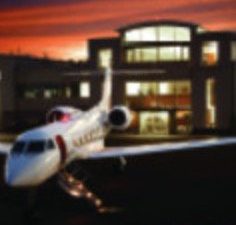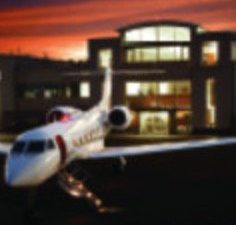Well Grounded
November 1, 2017


Once upon a time, not terribly long ago, general aviation terminals were, at best, functional and friendly. The coffee pot behind the counter was always on and the Naugahyde furniture squeakily comfortable. General aviation airports are home to fixed base operators, those providers of essential services like fuel, aircraft parking and maintenance catering to business and private aircraft. They were ready to fuel you up, fix a few “squawks” (problems) and get you on your way again.
Fast forward to the present and things are decidedly different. Today’s new crop of business jet terminals are ‘brass and glass’ enclaves, ever more dramatic oases in the fast-paced, high-flying private jet world that for an increasing number of corporations is a significant feature of business travel today.
With increasing frequency businesses need to put their people in places off the route maps of commercial airlines. “The US has about 5,000 public use airports,” says Dan Hubbard, senior vice president of communications for the National Business Aviation Association. “Of those, about ten percent – or 500 – have some service by the airlines. General aviation can use nearly all 5,000 of those and business aviation is a part of that.”
Tim Obitts refines the numbers further: the executive vice president of the National Air Transportation Association, an industry trade group that represents general aviation interests including FBOs, says 3,537 of those public use airports sport paved runways that are 3,000 feet or longer. Some 3,384 FBOs serve these general and business aviation fields.
Those fields are fertile these days. Look around the country and you’ll see FBOs at work erecting striking business aviation facilities that are anything but frivolous – despite their elegance.
First Impressions
Hardheaded economics drives the rush to construct new business aviation terminals. “Starting back in the early 1990s there was a desire by local authorities, by airports, to create a minimum standard for FBO facilities,” says Obitts.
Terminals, in essence, “would be a showcase, a first impression for the business traveler coming into the community,” a lens through which business guests, like venture capitalists and companies on the lookout for new economic opportunities, view the city. Airports “want to make a good impression to make sure they come back,” he says.
FBOs serve two audiences: passengers and pilots. Facilities have got to appeal to both. The passengers’ corporation may be paying the ultimate bill, but it’s pilots who get them there and back safely.
“I’ve heard of FBOs spending up to $30 million for their facilities,” says Andrew Perry, executive director of Houston Executive Airport, a bizjet mecca for the Bayou City located 28 miles west of downtown. “They’re spending that kind of money to service passengers and crews.”
Henricksen Jet Center is located at Houston Executive. It makes a practice of pampering pilots. “We have two crew snooze rooms,” says Perry. “That way they don’t have to go to the hotel to take a nap.”
Archrival Dallas has an FBO with “three crew sleep rooms with full-size restroom and shower,” says Cat Clay, manager of sales and marketing for Love Field’s BusinessJetCenter. Throw in a Golden Tee golf machine, healthy snacks and a year-round assortment of ice cream for good measure.
If pilots are pampered, so too are passengers. Perks at the Love Field center include three executive conference rooms and a special events room. Clay says there’s even a bucket of canine treats and an appropriate grass patch for furry four-legged fliers.
But passenger pampering can go well beyond C-suite conference rooms and doggy comfort stations. “I had an aircraft call us inbound one time,” remembers Betsy Wines, vice president of customer service and human resources at Meridian’s Teterboro, NJ, FBO. “The boss had forgotten his tennis stuff. He wanted to play tennis while he was here.” The inbound business jet called Meridian and said, “’We need sneakers this size, shorts this size.’ They needed to be a particular brand too. So we went out and got them for him before they landed.”
One of the most important passenger needs is an arrivals canopy to ward off sun and rain. In fact, canopies have become the hallmark of an increasing number of FBO terminals.
Business Jet Center can accommodate a Gulfstream G-450. Henricksen Jet Center boasts what Perry labels “the world’s largest arrivals canopy. Houston is a hot place, especially in the summer.” Passengers and crew are in the shade when they arrive or depart. The Henricksen canopy is commodious enough to shelter an MD-87 and a pair of Gulfstream G-650s side by side at the same time.
Privacy Please
Amenities notwithstanding, corporate business jet travel is predicated on speed. “In reality, passengers shouldn’t spend much time in our terminal,” says Wines, “They expect to arrive curbside or planeside, to be able to move quickly, either from the car to the plane or the plane to the car.”
At Meridian Teterboro, she adds, “For most of our passengers who are traveling through it’s the bare essentials – being able to walk through a well-maintained facility, get to their car quickly, use a clean restroom, have a cup of coffee and maybe grab a bottle of water along the way.” Many of Meridian’s business travelers are city-bound for Manhattan, 12 miles distance from the New Jersey FBO.
One of the prime selling points of business aircraft is that they provide airborne privacy, a place where candid conversation about, say, a classified business deal can be held without fear of being overheard. For example at LA’s Van Nuys airport, “the clientele based in the facilities are either-high-end investors or private individuals,” says Curt Castagna, president and CEO of Aeroplex/Aerolease Group, which just finished an $8 million, 50,000-square-foot facility at the airport.
“We cater to lots of people in the movie industry. Those folks want privacy and security. That’s the number one consideration for them: They want a facility that provides protection.” Castagna says his company listened to the clientele when it designed the new Van Nuys enclave. Conference rooms, security systems, access control systems – “we’re building them in.”
Proper Airports
In large cities small airports dominate the corporate aviation skyscape. That’s because big airports really cater to commercial carriers. “At the largest US hubs, general aviation is always a single percentage user,” says NBAA’s Dan Hubbard. “Because the airline presence is so pronounced that general aviation aircraft have every incentive to use smaller and secondary airports.”
These “pure” business and general aviation airports are located in or near major cities with lots of commercial airline service at major airports. Hartsfield-Jackson Atlanta International, the world’s busiest airport, is a classic case-in-point.
Business jets favor DeKalb-Peachtree Airport (PDK), just northeast of town and a 15 minute drive from upscale Midtown and Buckhead. After ATL, PDK is the state of Georgia’s second-busiest airport. Then on the west side of town lies Fulton County Airport (FTY), known to locals as Charlie Brown Field.
However some big city airports coexist nicely with general aviation, especially the turbine-powered jet variety. One of them is Dallas Love Field. Located a mere six miles north of downtown Dallas, DAL is favored by commercial and bizjet fliers alike.
Commercially, Southwest Airlines flat out dominates DAL. But because commercial traffic at DAL has effectively been capped by an agreement limiting the number of gates at the commercial terminal, Love Field-bound travelers aboard business aircraft aren’t beset by the sort of local air traffic delays that impact other airports of its size and city-center proximity.
The Signature Effect
Seattle’s Boeing Field (BFI) lies five miles south of downtown Seattle and at the epicenter of aviation history. Recently, Signature Flight Support opened a ‘glass and brass’ FBO at the airport, one of 200-plus FBOs it has worldwide.
Signature’s influence on the fixed base operations industry is seminal. The mass transformation of FBOs began in the early 1990s, contends NATA’s Tim Obitts, when Signature introduced concierge and VIP status to the once stolid, prosaic world of business aircraft travel.
Obitts believes this set off a chain reaction, not just with other ground-bound FBOs but with manufacturers of business aviation aircraft as well. “There was more demand for the manufacturers to have WiFi, larger cabins and more amenities to match what they were receiving on the front end (departure) and back end (arrivals)” of the trip.
In a pattern that Obitts says was manifested by “beautiful facilities,” waiting limos, refreshments, restaurant recommendations, “whatever they might want,” Signature’s success “created this high-end environment and others started following suit.”
The coffee pot is still around, but now it holds custom-ground brews. The furniture is still there in the waiting room. But it’s not Naguahyde. Not any more.
By Jerome Greer Chandler




